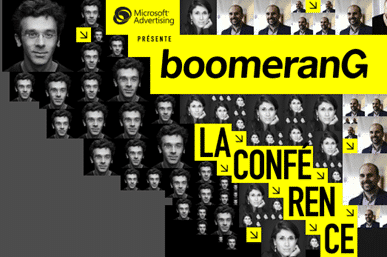Boomerang the conference: A day full of interactive and algorithms
extract test

The Boomerang conference day, organized by Infopresse, presented the best of what interactive technology can offer in Montreal. Here is a summary of some of the conferences I attended.
KEVIN SLAVIN – THE POWER OF ALGORITHMS
The day started with Kevin Slavin, professor of the MIT Media Lab. The title of his lecture, “MIT: the world is changing (and you should too)”, did not suggest the content he would present to us, namely algorithms.
Algorithms are so present in our lives that we often forget how much we are controlled by them. Whether you're on Google, Facebook, Netflix or Amazon, no human controls the content displayed; the algorithms themselves decide for you what you should see.
-png.png)
In the case of Google, having a search tool to search through the 100,000,000 web pages available is useful. However, it is legitimate to wonder to what extent we are controlled by it . It would be enough that Google does not want to display a certain site in its algorithm so that it goes unnoticed in the eyes of the world.
This may seem like a trivial matter, but imagine being an author who has their book on Amazon, but finds that the book only shows up on the 20th page on the search for the name of the book.
Mr. Slavin also spoke about the regulation of prices on Amazon according to algorithms. Like what people no longer see the real prices of products, but the price that the algorithm believes is a good sales figure.
All this seems very harmless, especially since we all know companies that have been operating this way for several years. However, we were also exposed to the algorithms that drive the stock market and all traders .
Each trading company on the stock market has its own powerful algorithm to decide which stocks to buy. What happens when an algorithm gets fooled by another algorithm?
Mr. Slavin's main point is that there must be humans behind these algorithms. An algorithm by itself needs theory and ideas to be really useful. For those afraid of algorithms, Slavin seemed to care a lot more about humans than algorithms…
JEAN-FRANÇOIS RENAUD – GO FURTHER THAN THE CPM
One of Adviso's associates presented “Master Class Campus 4: Using new Web media spaces: Google Adwords, Google Visual Ads, Facebook Ads”, a very short version of his training at Campus Infopresse .
I won't go into too much about it, so as not to spoil any punches for those wanting to do the training on campus, but let's just say that if you're still doing a lot of CPM, you should attend the training.
DÉBORAH HALL – THE POWER OF MOBILE
You are not taught anything by telling you that the motive is important. However, you have to look further than just geolocation . This is what Déborah Hall, Mobility Director Olive Media, tried to show us.
When you think of mobile, you also have to think of the emotional, the commercial, the social, but above all the discovery .
It was a short 15-minute conference, but the message was clear: mobile is much more than you think .
GRÉGOIRE BARET & MARTIN HUSARD – THE INTERNET OF THINGS
Your toothbrush is not yet connected to the Internet? So 2000. More and more, everything is connected to the Internet, even everyday objects.
Grégoire Baret, Executive VP at Nurun, and Martin Husard, Marketing Director at Sanofi, came to talk to us about how the world was changing, with the Internet infiltrating all spheres of our lives.
One of the interesting notions retained from the conference is overdesign: Often, we create too many interfaces for the same brand: a Facebook page, a mobile application, a Twitter account, a mobile site, a website and others, and we end up undoing a bit what the mark was at the start.
Constantly wanting to do something new and gimmicky presents many risks. And the user risk should not be overlooked: letting the reality of use slip away. Make an app that has no use, just to make an app that uses new features. Mr. Baret gave the example of BMW which made an application to open doors which is very complicated to use; the user ends up using his key.

You have to see the product as an accompaniment value, much more than just a product that has a specific utility for the user. Mr. Baret noted the example of Budweiser and its lamp which lights up when the user's team wins. It's not a lamp, it's the creation of a social moment.
Thomas.
.jpg)

-Sep-07-2022-08-25-30-70-AM.png)

.jpg)




